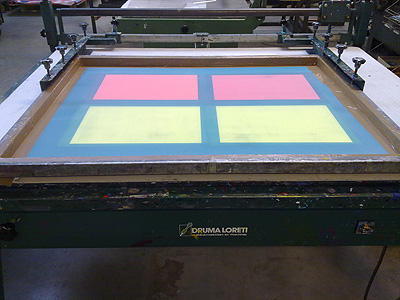Last week I went to the graphic arts workshop Daglicht in Eindhoven. They have a lot of experience with screen printing and didn’t expect any problems with my straight forward task. We started out with the exposure of a screen with a mesh size of 77 to get an area of 60 by 40 centimeters. The idea was to have a big square from which I could cut two or three display areas.
The first area we printed was a complete disaster. Hardly any ink was printed on the fabric. We decided this was due to the old ink we used. In the specifications it sais that mixed ink must be used within three months. This ink was around four weeks old and should have been okay…
To exclude all risks we mixed fresh ink. But the results were still very poor. We got uneven prints which aren’t suitable for my goal. It became clear that the ink dried extremely fast on the screen, thus clogging the screen. After an afternoon of experimenting and printing very fast with meager results we had one final try. We reduced the screen size to around A4 and used a mesh size of 43. We printed full contact, just put the screen on the fabric. Finally got some acceptable results.
Of course this is very nonstandard procedure so I phoned the supplier. He contacted the firm in Great-Brittan who even did some tests with my batch. The saw no drying on the screen. The only advice they could give was to spray the screen lightly between prints. But this would delude the ink, making it less opaque. I decided not to go that way and stick with what we had discovered ourselves.

I exposed a new screen with a 43 mesh allowing for four pieces of fabric of 27 by 40. We placed the screen only just off contact, did a flood stroke twice and cleaned the screen after two prints. I now have a collection of printed fabrics in three colours and some spare pieces for the future.
The next step is to glue the conductive fabric to the printed fabrics.